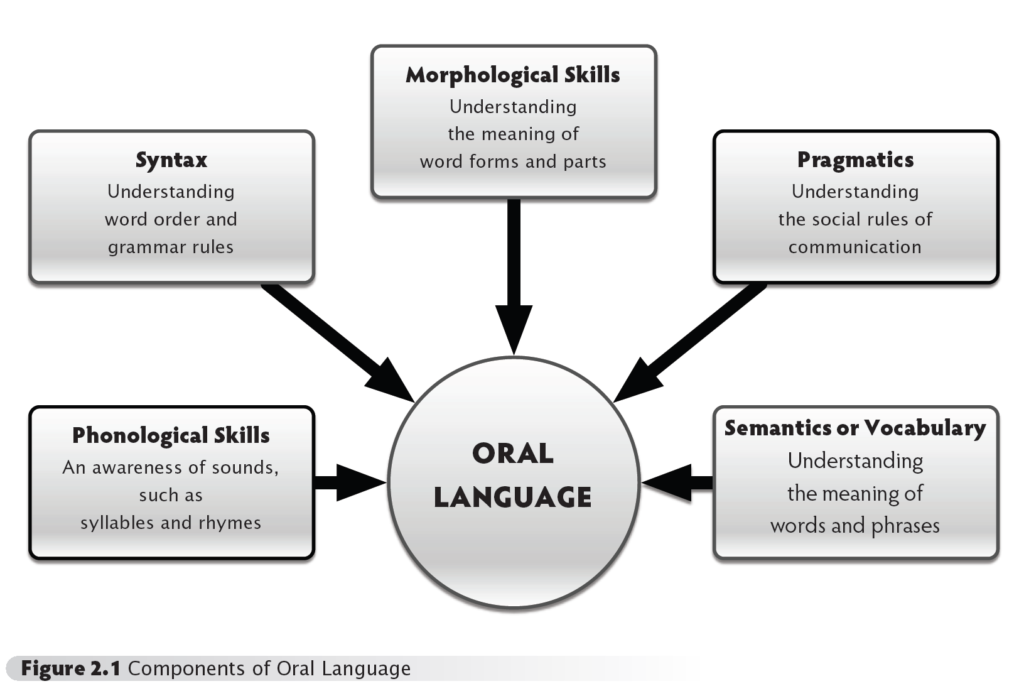The connection between oral language development and reading proficiency is symbiotic, with a key emphasis on oral skills as the foundation for understanding written text. Nurturing these skills is especially critical for younger, non-reading children, as the symbiotic relationship between oral language and reading is not yet accessible to them. As reading skills progress, comprehension of written text aligns with earlier language comprehension.
One thing to note is that individuals with dyslexia may excel in oral language but struggle with decoding words, impacting print comprehension.
The spoken word, a powerful tool of communication, serves as the gateway to unlocking the vast world of written language. Children naturally build oral language skills through various experiences and interactions, including listening, speaking, and engaging in meaningful conversations. The ability to comprehend spoken language and to express oneself verbally forms a strong base upon which the intricate structure of reading comprehension can be built.
Every child is unique, and language development occurs at different rates. Providing a language-rich environment, being responsive to children’s attempts to communicate, and fostering a love for language through enjoyable activities are fundamental in supporting the development of strong oral language skills.
Components of Oral Language Development
There are five key components of oral language. These include:

Phonology
Phonology is a branch of linguistics concerned with the systematic organization of sounds in language. Children build capacity to process speech sounds with activities such as rhyme recognition, and identifying and manipulating syllables and individual phonemes in words.
Syntax
Syntax pertains to the art of assembling words and phrases into coherent sentences. When children adeptly construct sentences that adhere to the established structures of language, they showcase their syntactic skills.
Semantics
Semantics involves grasping the meanings of words, phrases, and sentences, as well as employing word meanings accurately. This includes tasks like labeling objects and categorizing words which fall hand in hand with vocabulary development.
Morphology
Morphology involves comprehending the smallest components of words and their respective meanings by recognizing prefixes, suffixes, and roots Morphemic analysis can be beneficial to learners in building vocabulary.
Pragmatics
Pragmatics encompasses the social conventions of language, involving an awareness of conversational norms and the ability to adjust speaking and listening behaviors to align with the situational context.
As children progress in their oral language development, they naturally build essential comprehension skills. The ability to understand spoken language effortlessly translates into the capacity to comprehend written text. Proficient readers draw upon their oral language foundation to infer meaning, make connections, and engage with the material on a deeper level.
It is important to understand that individuals with dyslexia may face unique challenges in this progression. Despite possessing strong oral language skills, students with dyslexia often encounter difficulties in decoding written words, affecting their ability to navigate text. For these students, additional support in decoding strategies and tailored interventions can bridge the gap between robust oral language abilities and challenges in print comprehension. Addressing these specific needs ensures a more inclusive approach to literacy development.
Activities to Build Oral Language Skills
Conversations
Conversations, both at home and in the classroom, help to nurture oral language skills. Encouraging open-ended discussions, active listening, and thoughtful responses creates an environment where children can develop the communication skills necessary for effective reading.
Storytelling Sessions
Encourage students to share their own stories or retell a familiar tale. Discuss characters, settings, and plot elements to enhance descriptive language. You can even have students engage in role-playing scenarios to promote conversational skills and understanding of different perspectives. This can be particularly effective for practicing pragmatic language skills.
Listening Activities
Play audio recordings, podcasts, or stories and discuss what was heard. Ask students to arrange key points in chronological order. This enhances listening comprehension and the ability to summarize information.
Oral language takes center stage when it comes to literacy development. The journey from spoken words to written text is a continuum, and a strong oral language foundation is the key to unlocking the full potential of reading proficiency. As educators, parents, and advocates for literacy, we must recognize the vital role of oral language development in shaping the literate minds of our youngest readers.
Resources
- https://www.languagemagazine.com/5100-2/
- https://files.eric.ed.gov/fulltext/EJ1293447.pdf
- https://www.researchgate.net/publication/281110062_Oral_Language_Development
- https://buffettinstitute.nebraska.edu/-/media/beci/docs/oral-language-development-nancy.ashx?la=en#:~:text=Oral%20language%20is%20made%20up,also%20referred%20to%20as%20semantics).
Please connect with us on Facebook, Twitter, Instagram, LinkedIn, and Pinterest to get tips and tricks from your peers and us. Read the IMSE Journal to hear success stories from other schools and districts, and be sure to check out our digital resources for refreshers and tips.
